10, 11 — pelvis rotation in squatting
position.
11
63
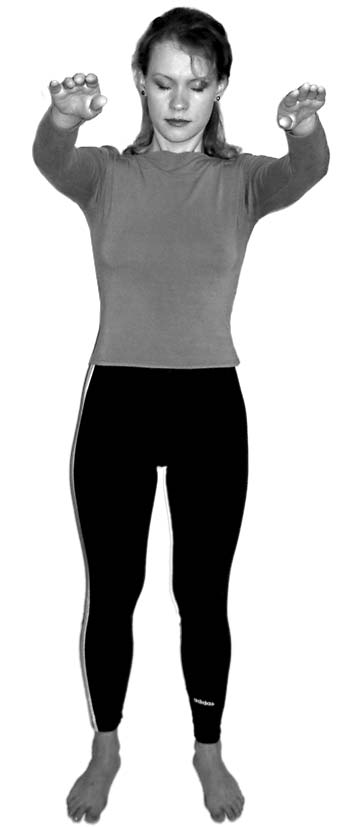
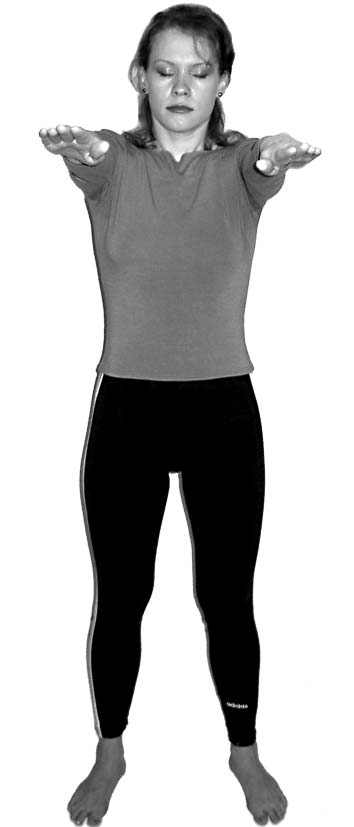

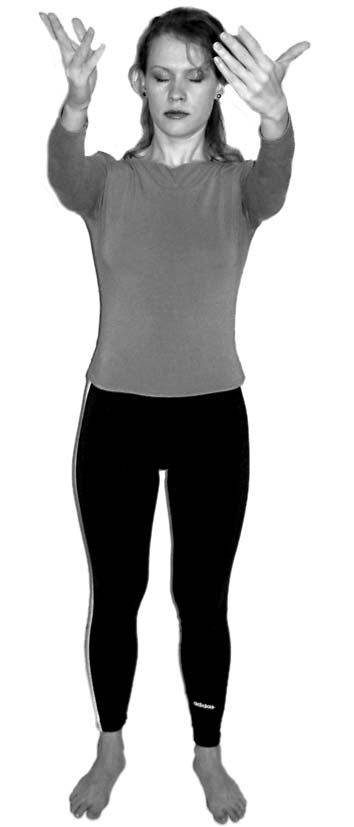
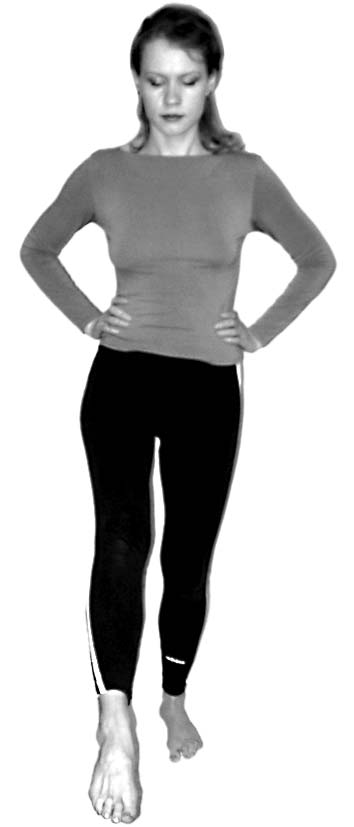
. Safronov. Yoga: Physiology, Psychosomatics, Bioenergetics
Dizziness and difficulties in getting the balance show that the con-
sciousness is unstable.
The state of Muladhara can be diagnosed by the person’s capacity
to bend. If you can bend with your spine straight (just by your pelvis,
with no bending in lower back) for more than 90 degrees Muladhara is
integral.
At the beginners level it is better to do the warming-up with the
Muladhara set-up. Doing exercises you should pay attention to the feel-
ing of warmth in your joints. Every exercise should be done till the heat
in the needed joint.
2
3
1
Mistakes in doing warm-
up exercises (beginners
level)
1 — arms are involuntarily
folded in elbows (Anahata
is breached or depressed)
2 — lifted shoulders cover
the neck (indicates
a breached Vishuddha)
3 — arms go apart
(Anahata is over excited)
4 — energy «stuck» in Ajna
5 — hip goes ahead
4
5
(indicates rigid
Svadhisthana)
64
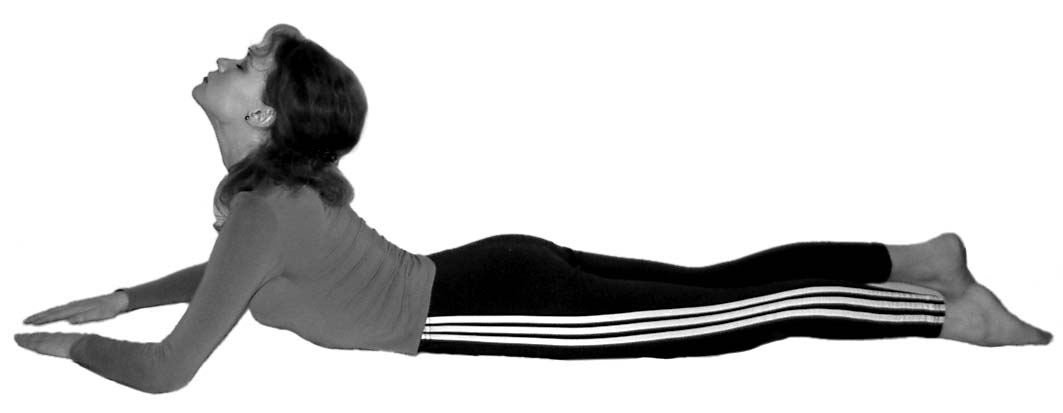
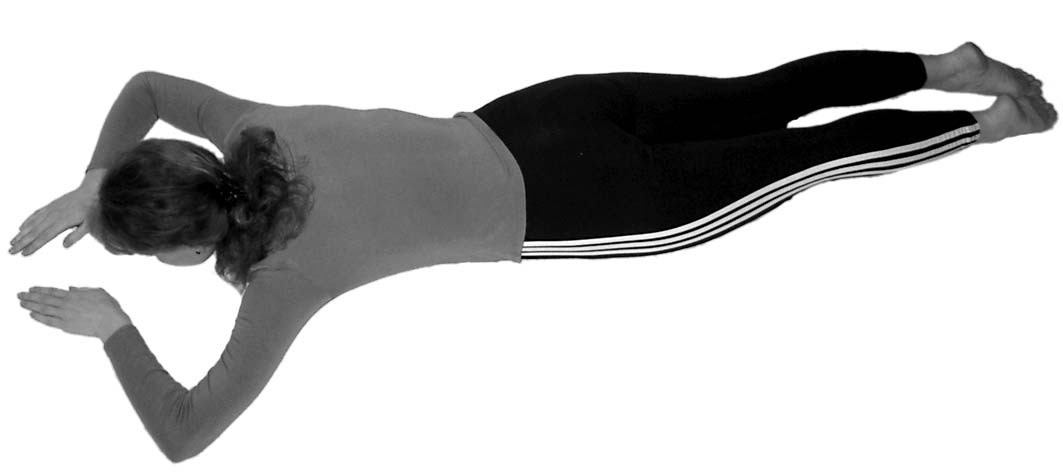
First steps in hatha-yoga
The most common
exercises and general
mistakes in doing them
(beginners level)
Basic group of asanas
Bhujangasana (cobra pose)
Starting position. Lie on the ground face down, your head rest-
ing on your forehead or the chin, legs together, toes stretched out. The
palms of your hands should be put on the ground slightly before your
head, fingers extended, distance between hands about 20 cm. All the
body, especially your shoulder blades relaxed as much as possible.
NOTE that having problems
with the heart chakra the prac-
titioner will unconsciously
bring his hands together or
even joint his fingers, reducing
chakra’s energy effect, so this
should be watched.
Technique. At the exhalation do a slow backward arching with
the spine, lifting vertebras one by one starting from your neck down to
the lower back. Stay in the final position, breathing rhythmically. Going
down is done at the exhalation, i.e. ending the position, we bring down,
like a snake, by turns vertebra of the lower back, then of the thorax and
of the neck, finally lying down the head.
65
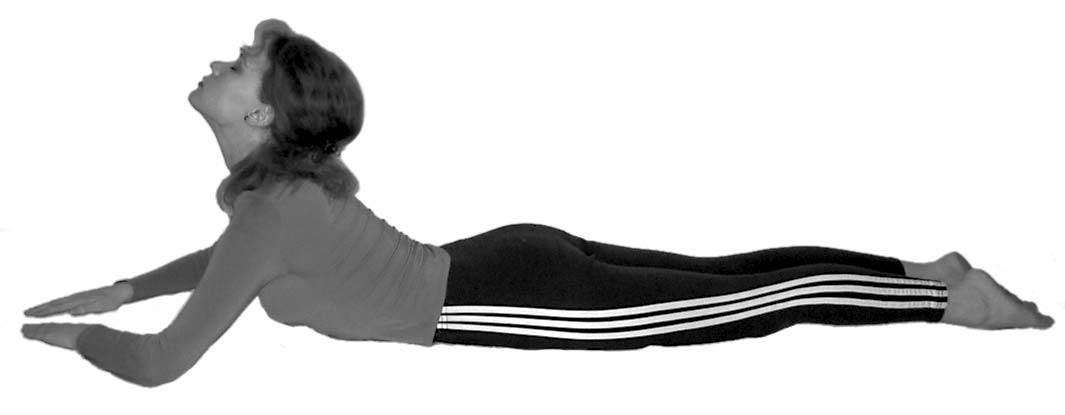

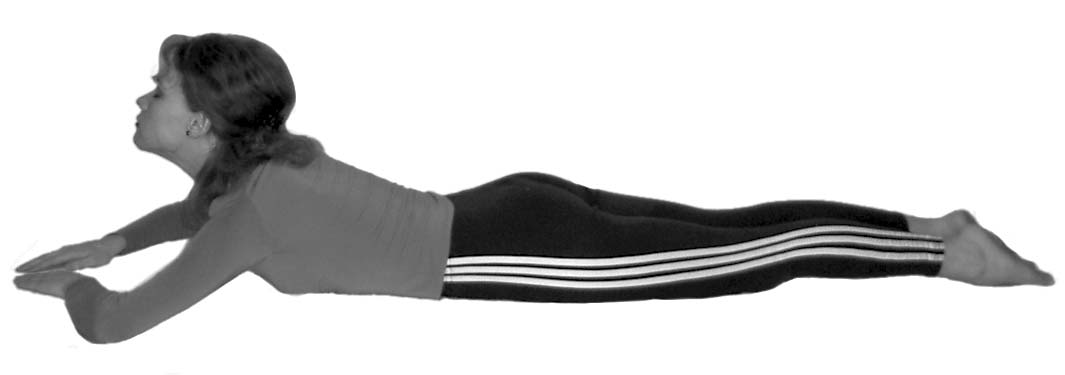

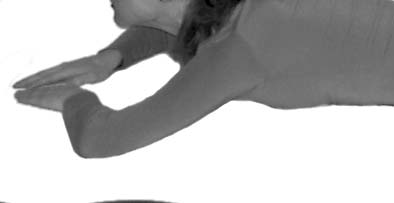
. Safronov. Yoga: Physiology, Psychosomatics, Bioenergetics
Phases of entering
Bhujangasana
Particularities of performing. The feeling of a strained anterior-
middle channel should move from the head down. Staying in the main
part of asana, you should keep this strain long all the meridian. «Let-
ting down» the tension at any part completely reduces to zero all the
effect from the asana. Most often we take off the tension in the neck
zone (the practitioner stops throwing back his head). In this case energy
doesn’t go up in the head and «sticks» in the shoulders, stimulating the
development of osteochondrosis.
Here is the energy mechanism of this asana. Consequently en-
tering asana we stretch our anterior-middle meridian1, opening it. To
open an anterior-middle meridian you have to stretch it so that the
energy could flow in it, but it has to be stretched completely (at the
full length), gradually and successively. The energy is gathered in the
lower part of the body and after staying in the pose (when beginners
start practicing yoga and still have «dirty» channels, the effect can come
even after asana) it goes up the spine channel, which is accompanied
by the warm or even hot feeling moving up, to the head. Such an ef-
fect from Bhujangasana is mentioned in «Gheranda samhita».
«Fire of digestion in the body will rise intensively, all diseases will be cured
and the snake-like Goodness (Kundalini) will wake up and rise thanks to
practicing Bhujangasana» (2.43).
After asana the face and the ears can become red. The rising heat
determines for how long you must stay in the posture.
1 Speaking about meridians we use Chinese terms, although those meridians by which
energy flows, in yoga aren’t completely the same as in Acupuncture, because the are located
not on the surface, but deep in muscles. Nevertheless having no other elaborated terminology
we’ll use the closest one.
66
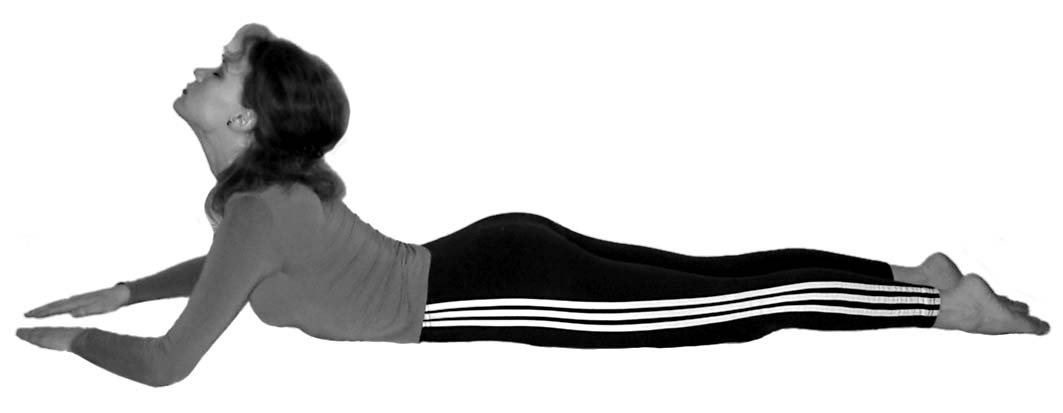

First steps in hatha-yoga
Every asana must be
done till the needed energy
effect from it is achieved.
Staying in it longer is
1
needless1.
Exiting the pose, we
close meridians, at the same
time «smoothing» and re-
turning the non-lifted by
the anterior channel en-
2
ergy back by the posterior
meridian. The understand-
ing of energy mechanism
explains the importance of
entering and exiting the Mistakes in doing Bhujangasana
pose correctly. The channel 1 — buttocks are strained and lifted (energy get
opens when it is stretched stuck in pelvis); 2 — no tension in the neck and
at all its length. The block thoracic spine (energy wil get stuck in shoulders).
just in one place completely
changes the energy picture of asana: the energy so to say sticks in the
blocked zone, which can lead to unpleasant feelings and even provoke
diseases. The most common mistake in entering this pose is not to lift
the heart zone and after lifting the neck continue arching the lower
back. As a result the energy doesn’t go through the anterior channel
and doesn’t go up the posterior channel. The heart vertebra doesn’t ac-
tivate and the lower back vertebra gets traumatised because of the too
zealous performance.
After this asana you should lie down for 1-3 minutes, practicing
rhythmical breathing. As it was already said, the heat can go up even
after doing the pose. Energy passes at a certain speed. The «cleaner»
your channels are, the faster energy passes. When the beginner starts
practicing yoga, his channels are quite «dirty», so that it takes up to
3 minutes for the energy to pass, but later this process can take some
seconds.
The inner criterion of doing Bhujangasana right is the heat you
feel, when the energy passes. After some practices there will be less
heat, which means the asana can be intensified, for example, by putting
your legs apart.
Initially you can feel other things than heat: pricking (like when
your limb grew numb), chill, vibration, shivers etc. These sensations
can appear when you start doing yoga and clean your channels (espe-
cially pricking, localized around the problem zone).
1 This rule is true for beginners.
67
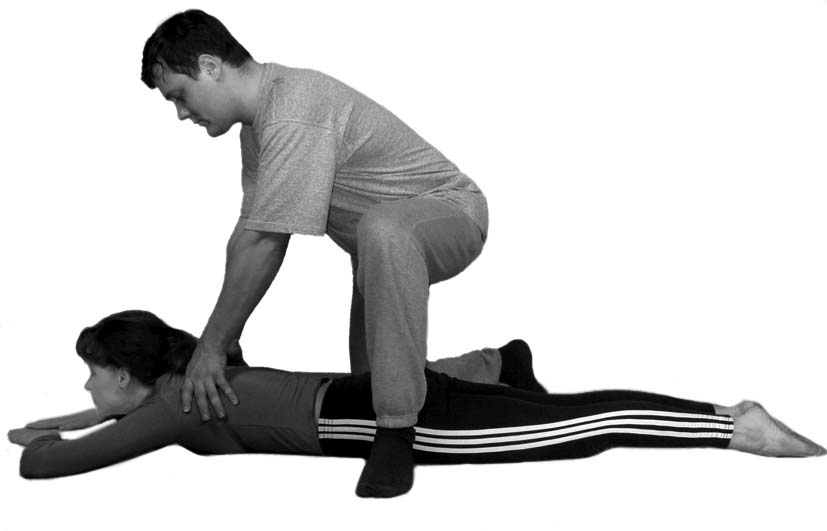
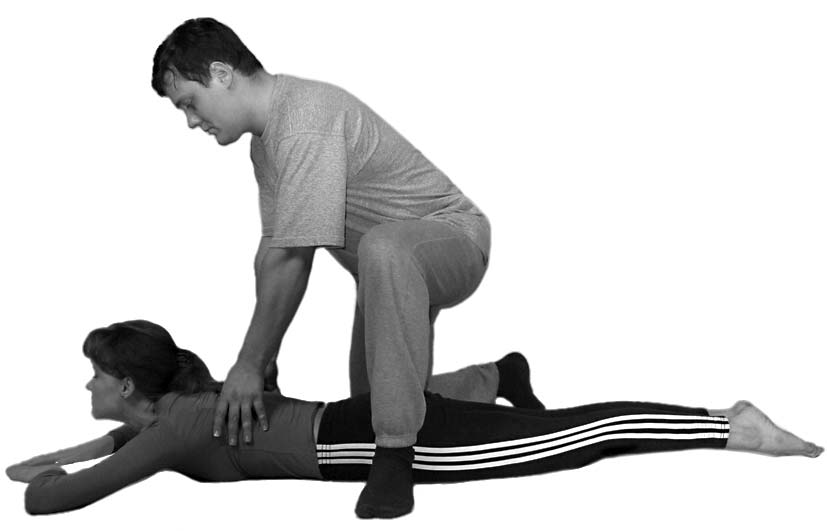
. Safronov. Yoga: Physiology, Psychosomatics, Bioenergetics
Making Bhujangasana with the assistant
The assistant immobilizes practitioner’s back, preventing the tension
to «slip» problem zones in the spine.
It is important to do Bhujangasana only by longitudinal muscles
of the back. Arms don’t participate in this asana, to check for this try to
lift your hands while being in the pose. In this asana only the foresaid
muscles of our back are working, not those of legs, jaws, eyes, fore-
head, which can strain by reflex. Such correlations we call «pathogenic
arches». In most cases these are stereotypes of movement, formed mis-
takenly and making people waste some energy for nothing. To break
down pathogenic arches — to master every group of muscles — is one
of hatha’s goals.
Understanding how important it is to do asanas correctly, and
that initially we tend not to notice our problem zones, it makes sense
to start learning Bhujangasana and other basic postures with the help of
another person, who’d control, if you enter and exit the pose correctly.
Every zone must be evenly activated. Your assistant can hold tight
your spine with his hands, preventing the lower back from arching be-
fore the thoracic spine. He mustn’t press, just set it. His fingers must
stay on the muscles long the spine, not on your backbone. When a per-
son lies relaxed it is easy to feel. Longitudinal muscles are relaxed when
there is no tension and no contractions in them. If the practitioner goes
up by these muscles (Bhujangasana isn’t a push-up, it doesn’t involve
hands at all), all muscles long the spine are straining evenly bottom-up.
Your assistant can feel, when the tension comes to his fingers, stop you
in this position and move his fingers 2–3 dossals down. Then you con-
tinue arching and gradually come to the fourth vertebra. This way you
breathe normally and should be controlled not to relieve strains in your
neck — the energy will stop moving to the head and osteochondrosis
can be provoked.
68
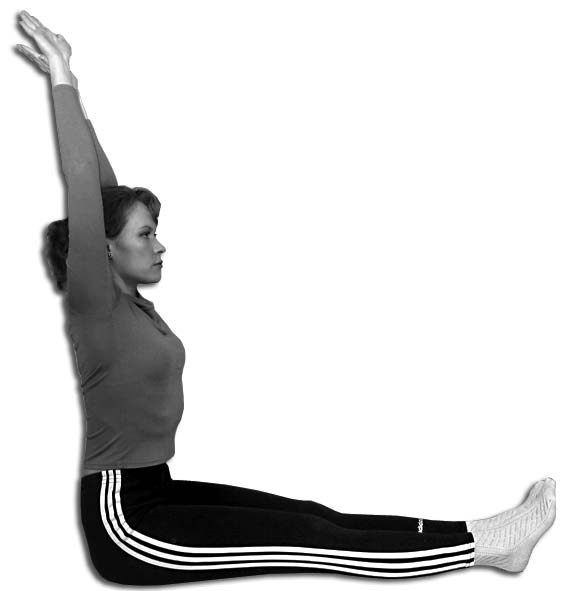
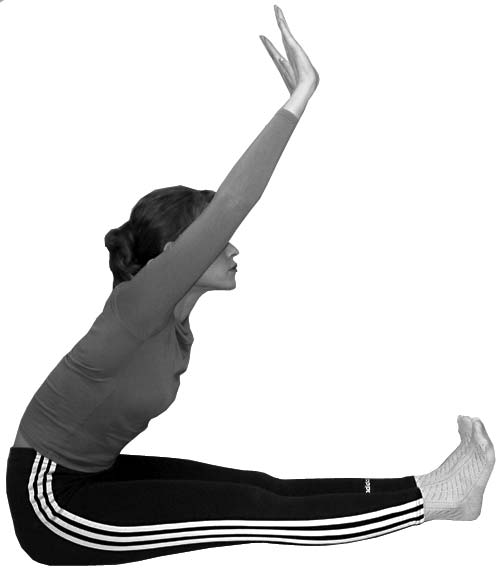
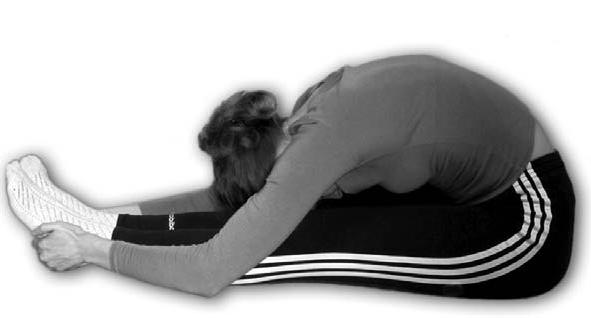

First steps in hatha-yoga
Pashimottanasana
(straining spine pose)
Pashimottanasana is a counter
pose after Bhujangasana.
Starting position. Lie down on
your back, feet together, hands long
your body.
Technique. Inhaling to the full,
stretch your hands above your head,
stretch you body from fingers to toes. Ex-
haling, sit down, making 90º with your
body, hands above the head, parallel to
your upper body. Then as if someone is
pulling you by the hands, bend ahead to
your legs, starting from lower vertebra up
the spine. Stay in this position, breathing
rhythmically.
To exit this pose, do everything in
the reverse order: from your head zigzag-
ging, first stretch out your chin, arch with
your chest, raise your torso and then lie
down on the back. It is important to en-
ter the pose this way, because we open
our posterior-middle meridian bottom-up
from toes to top, which means we must
close it the same way — top-down. So we
must exit the pose this way, «snake-like»,
as if entering Bhujangasana. Exiting asana
this way, we not only close our channel,
but also stabilise the energy. For exam-
ple, you have brought some energy to the
head — it will partly go down the ante-
rior-middle channel, the rest won’t make
it. Not to have a heavy feeling in your
head after doing this asana, we drive the
Phases of entering the asana
rest of energy down the posterior-middle
channel, exiting the pose «like a snake».
69
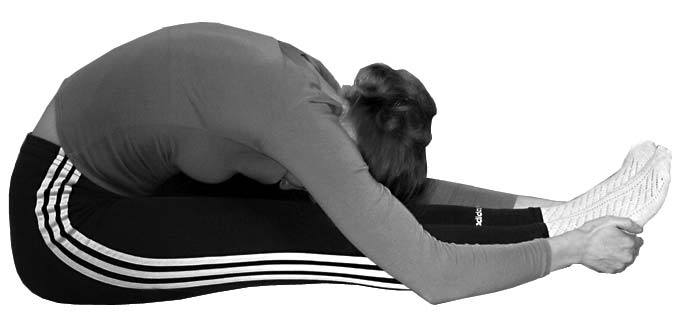
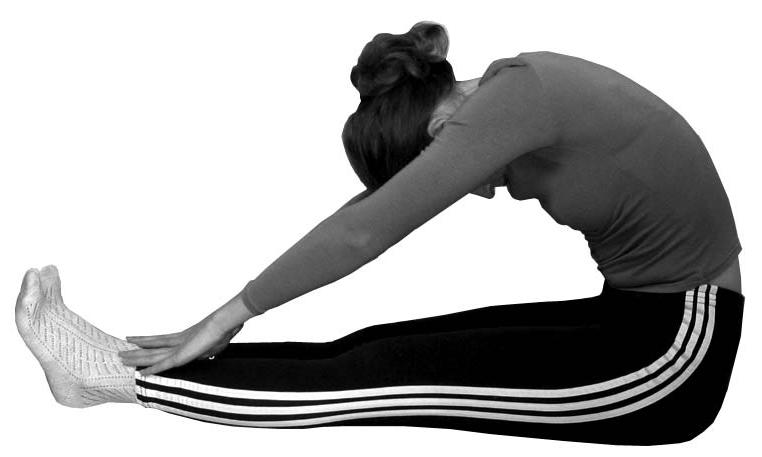

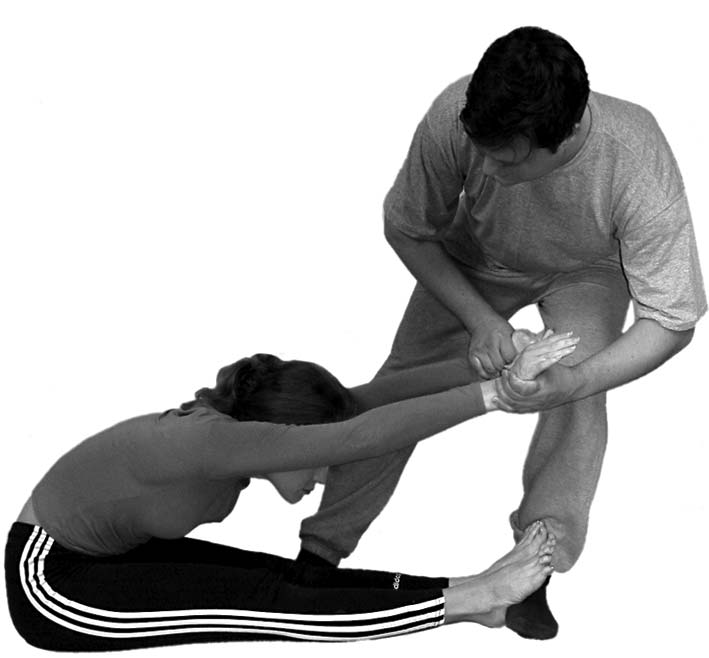
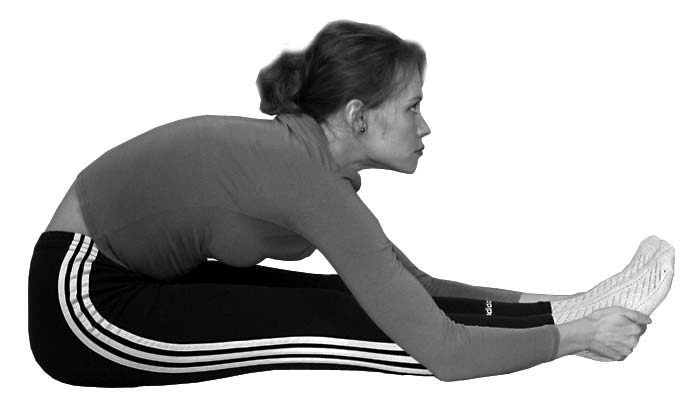
. Safronov. Yoga: Physiology, Psychosomatics, Bioenergetics
Particularities of performing. The
feeling of tension in posterior-middle
channel should move bottom-up. Stay-
ing in the static part of asana, you should
keep the tension long all the meridian:
from top to toes. Breaking in this tension
closes the channel and brings to zero all
the effect from asana. In addition to mak-
ing energy move, this pose can also acti-
vate etheric tockays in the external field,
i.e. in the outer part of our etheric body,
surpassing our physical body, around us.
The first clue to work with this energy is
to move your hands right. In asanas the
etheric energy follows the hands. So hands
must always be straight and strained.
PICTURES Phases of entering
the asana
Mistakes in doing
Pashimottanasana
No tension in lower back and
buttocks, energy channels
in legs are not activated. The
excessive bending in thorax can
lead to raised blood pressure.
Doing asana with an assistant
Assistant pul s by hands, providing even tensioning of the back
70
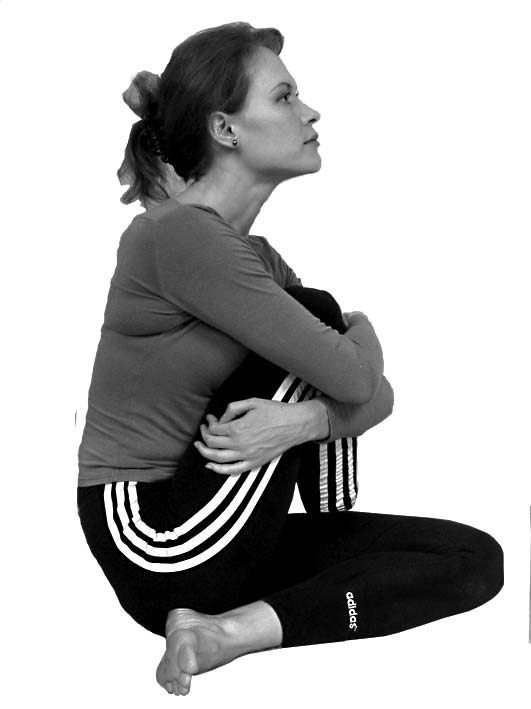
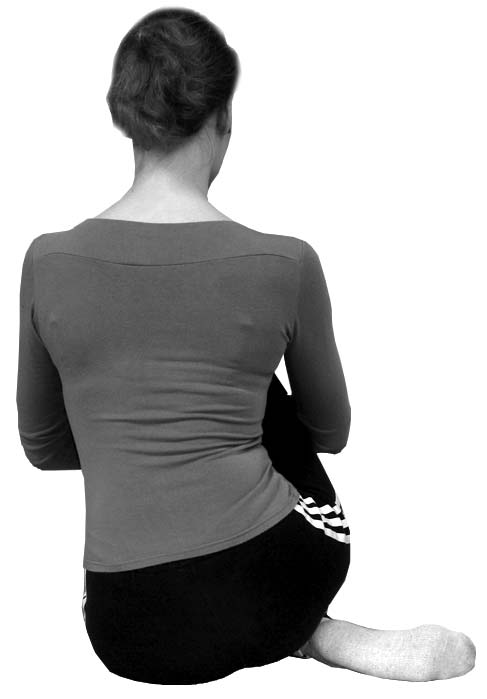
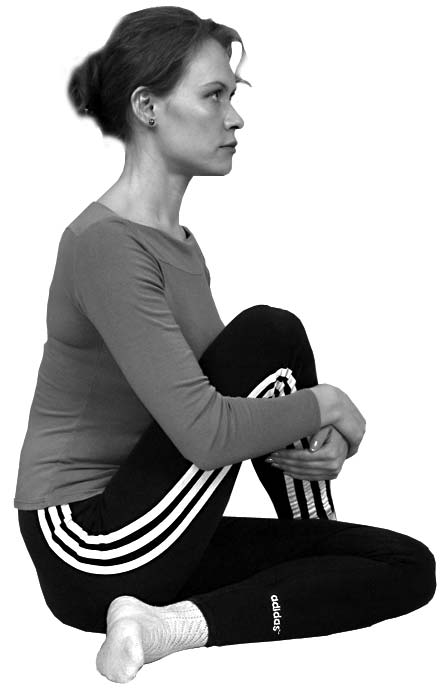

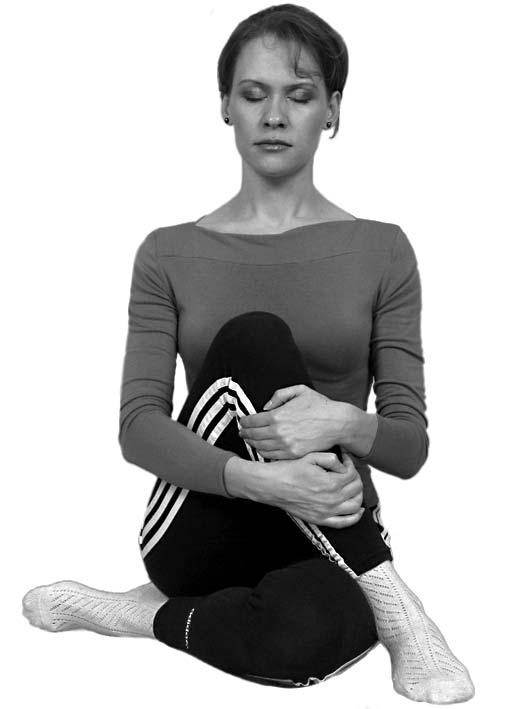
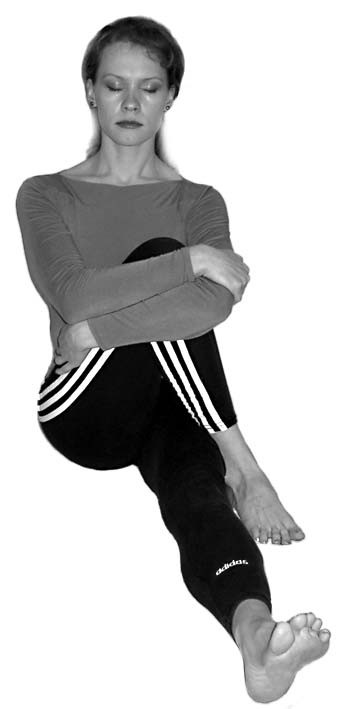
First steps in hatha-yoga
Vakrasana (curved pose)
Vakrasana is one
of
the
local- stretching
squeezing poses.
Starting position. Sit
on the floor.
Technique. Put one foot to the opposite
buttock (as if entering the lotus). The other leg
A simplified variation
bend in the knee and put over the opposite
of vakrasana
hip, the foot parallel to this hip. The back is
straight and perpendicular to the ground. The
shoulders are at one level, both buttocks — on
the ground. Slowly pull the knee to our chest
to feel the strain in the buttock. Pain in the
buttock is explained by a non-realised sexual
energy, which we assign to our body.
Particularities of performing. You
shouldn’t crook to the knee or pivot to reach
it. The posture must be absolutely straight.
Mistakes in doing Vakrasana
1 — the lower back is crooked (no tension in a buttock); 2 — one of the buttocks doesn’t
touch the ground (energy gets stuck in the kidney); 3 — not the knee is reaching the
body, but the body goes to the knee.
71
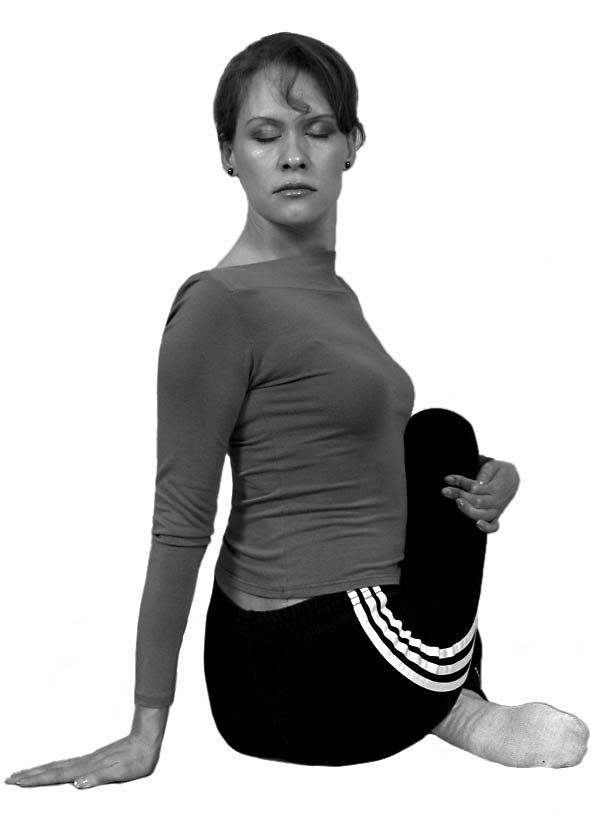
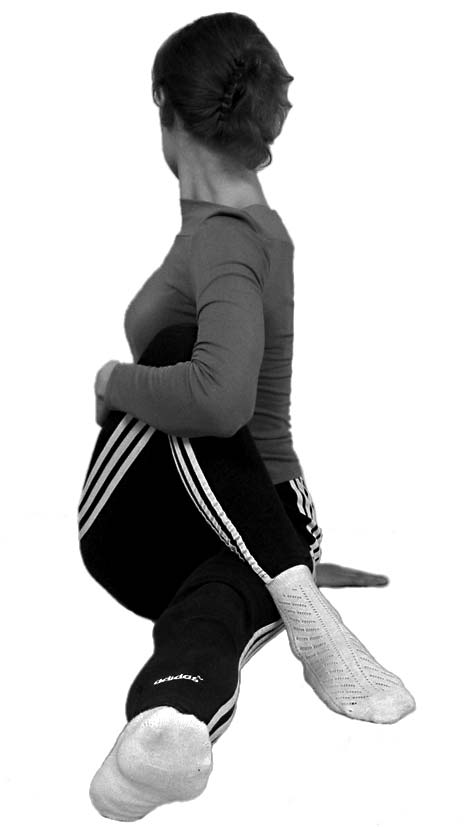
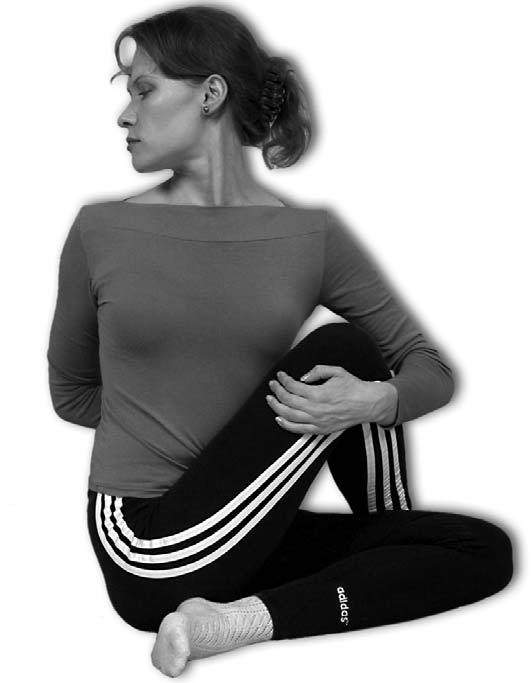
. Safronov. Yoga: Physiology, Psychosomatics, Bioenergetics
Arthamatsiendrasana
(pivoted spine pose)
Starting position. Vakrasana.
Technique. Pivot your spine in the
direction of your upper knee, to rest on it.
Your back must stay absolutely straight,
shoulders at the same level. Don’t lift your
buttocks off the floor. Pivoting must be
even — from coccyx to upper cervical ver-
tebra.
Particularities of performing. You
should achieve a feeling of even tension-
pivoting of longitudinal muscles of your
back: from the head to the coccyx. In this
asana the spine must be perfectly straight
and perpendicular to the ground.
Arthamatsiendrasana is a very effi-
cient pose in treating osteochondrosis and
scoliosis, but on conditions that it is done
correctly, i.e. with the straight back. If
these conditions are not fulfilled, the per-
formance of asana can worsen these dis-
eases.
A simplified variation
of Arthamatsiendrasana
72
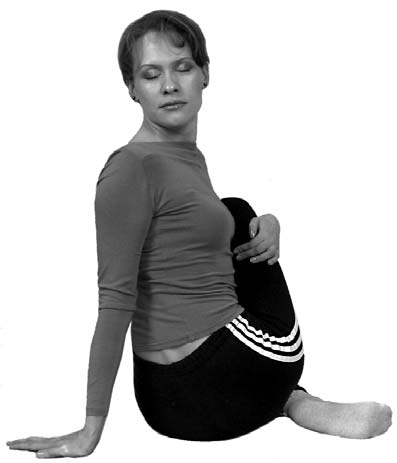
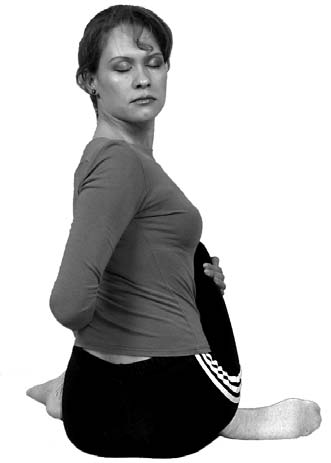
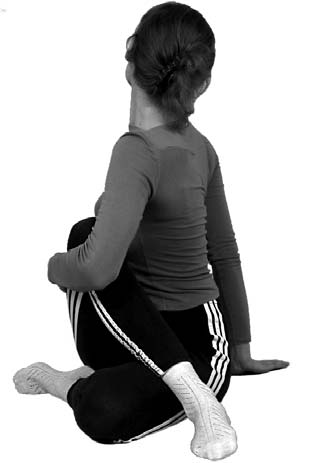
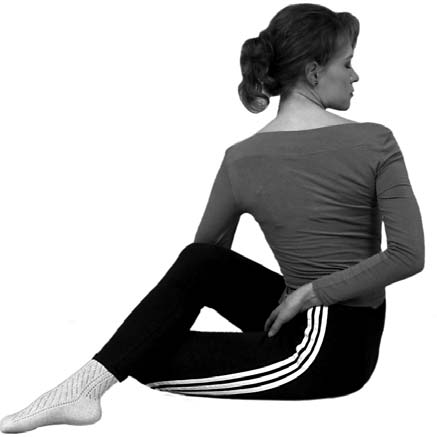
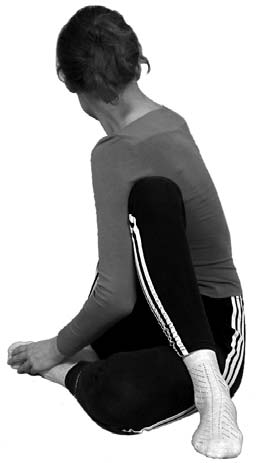
First steps in hatha-yoga
1
2
3
Mistakes in doing Arthamatsiendrasana
1 — one of the buttocks is off the floor;
2 — no pivoting in lower back (energy goes
up not from buttocks, but from Manipura);
3 — head is thrown back (energy blocked
in the neck); 4 — S-formed spine (tension
from pivoting is lessen, energy dispersed
in the back); 5 — the crooked back
(such performance causes microtraumas
in intervertebral disks and provokes
osteochondrosis)
4
5
This is a completely balanced complex for beginners. To do it
thoroughly and with no hurry, it takes about 15 minutes. You should
never hurry to do exercise and learn to take pleasure from every asa-
na. This complex cleans main meridians and drives energy by the main
round, which can be correlated with the microcosmic orbit in Chinese
tradition. If you practice at your own, you can do this complex during
one month. After that you’ll become used to these exercises, and the ef-
fect from asanas will diminish. In this case (and only in this case!) you
can (and should) widen this complex and add some more complicated
asanas.
When people start practicing yoga, they can get agitated (espe-
cially, if they feel an effect from asanas): they want to practice more, to
do more asanas etc. It is the wrong way. Firstly passionate desires burn
out quickly, secondly the amount of energy you can accumulate during
one yoga session is limited by the capacity of your chakras. In a one-
litre jar you can put only one litre of water. With time and practice this
volume will increase together with the energy potential of the practitio-
ner. At this point you can spend 40–50 minutes doing yoga, including
hygiene, warming-up and rhythmical breathing before going to sleep —
it will be enough. The hurry is a state where our energy runs before us,
to the future, that’s why we can’t reach it. We should work with our-
selves gradually without violence.
73
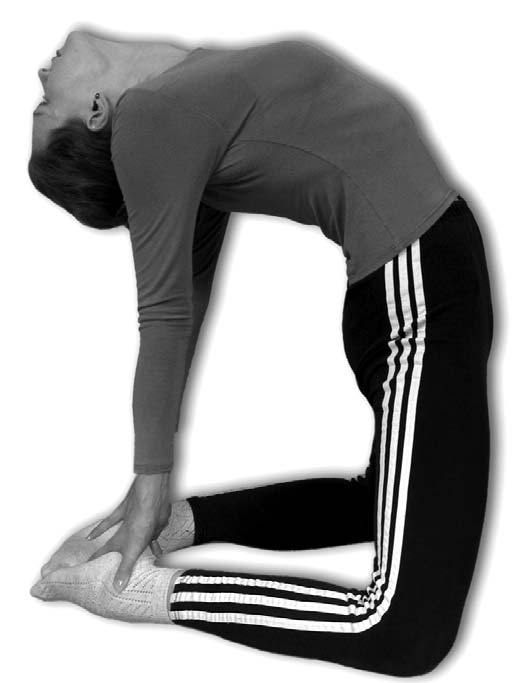
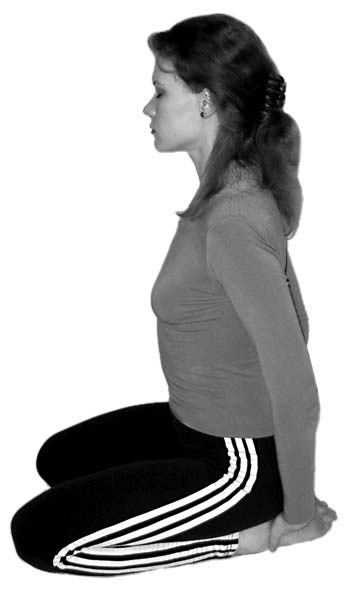
. Safronov. Yoga: Physiology, Psychosomatics, Bioenergetics
Second group of asanas
Mastering this group of asanas should be done after having mas-
tered asanas of the first group, as well as when the physiological effect
from them diminishes (there is no more physiological sensation of heat).
In the yoga complex these asanas should be done after the postures of
the previous group, because they provide the more intensive «untwist-
ing» of energy as for its density and the length of trajectory (activating
channels in arms and legs).
Ushtrasana (camel pose)
As for its action and technique,
this asana is similar to Bhujangasana,
but it is «more powerful», because it
uses gravity and activates the hips.
Starting position. Take an on-
knee position «Japanese-like», feet on
toes, hips open at 15 degrees (in yoga
this position is called «vadjrasana»).
Technique. Inhaling, arch in the
spine, starting from upper vertebra,
like in Bhujangasana, gradually stretch-
ing out anterior-middle meridian. At
last stick ahead your pelvis, grab your
heels by your hands and rely on them.
Exit exhaling in reverse order, straigh












































